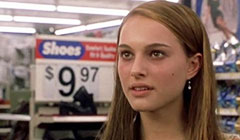|
|
|
|
Where the Heart Is
|
 |
|
Matt
Williams’ Where the Heart Is (not to
be confused with John Boorman’s wild 1990 film
of the same title) is a tearjerking, ordinary-people melodrama in the vein of Steel Magnolias (1989) and Fried Green Tomatoes (1991). Like those
hit movies, it is about extended families, personal resilience and difficult
loves – and it puts the accent firmly on women’s experience.
It
starts with the barest touch of social satire. Young Novalee Nation (Natalie
Portman), heavily pregnant, is deserted by her no-good boyfriend, Willy (Dylan
Bruno), in a car park. So she hides out every night for weeks in a supermarket,
and is luckily discovered just as she is about to give birth. Instead of being
incarcerated as a criminal, Novalee is hailed in the media as a folk hero, and
set on her merry way.
However,
love and pain and the whole damn thing are just beginning for Novalee. The
tough times are eased by a string of caring friends, including the spiritually
fanatical Sister Husband (Stockard Channing), worldly-wise Lexie (Ashley Judd)
and a shy librarian, Forney (James Frain). Catastrophes are always signalled to
Novalee by a dreaded sign: occurrences of the number five.
More
attention has been given to the quirky character names (to top things off on
that plane, Novalee calls her child Americus) than to just about anything else
in this oddly cold, overly calculated movie. Naturally, all sentimental stories
of this type are extravagantly contrived and emotionally manipulative; one
expects no less. In Where the Heart Is,
however, the themes are paper-thin, the plot seams show badly and our
engagement with the characters never really happens. Only the uniformly
excellent performances keep us watching.
Ron
Howard’s usual scriptwriters, Lowell Ganz and Babaloo Mandel (Parenthood, 1989), are veterans at
crafting smooth entertainments that juggle many characters and parallel plots
while deftly skimming over potentially tricky or painful issues. The lumpy
structure of this piece (adapted from Billie Letts’ novel) defeats even their
combined ingenuity.
Where the Heart Is is
founded on the hoariest chick-flick cliché – that most men are base, selfish
and rotten, except for the occasional sexless, ego-less, angelic type who will
sacrifice everything for a good woman in a jam. To pound this theme home, the
film sets up a double narrative trajectory vaguely reminiscent of the far
superior Crazy in
Alabama (1999). Alongside Novalee’s travails, we also follow the
rather dull journey of Willy into a music career (his agent Ruth, played by
Joan Cusack, at least provides some humourous respite). Matt Williams, a
successful producer-writer veteran of TV comedy series including Roseanne and The Cosby Show, has directed only one subsequent feature, and it’s
in a similar family-drama vein: Walker
Payne (2006).
Where the Heart Is quickly becomes a sprawling chronicle of the often dramatic changes in every
character’s life – with the worst traumas always kept discreetly off-screen. The
filmmakers are forced into using numerous large-scale ellipses or narrative
leaps, filled in by the usual ceremonies (birthdays, weddings, funerals) and
clumsy verbal backtracking.
In
theatre, we are used to vast gaps in time and space between successive acts. In
a novel, it is an easy trick to write “five years later …”, followed by a
summary evocation of what has been adroitly skipped. However, in cinema, strong
and obvious ellipses of important plot action always register as veritable
holes punched in the fabric of the fictional world. Modernist filmmakers like
Michelangelo Antonioni turn such holes to their advantage; Where the Heart Is simply disappears through its own cracks.
© Adrian Martin August 2000 |
![]()